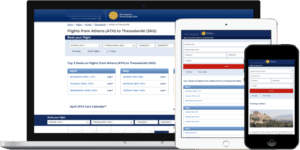In response to the pressure OTAs and MSEs have put on their bottom lines, airlines are renewing their focus on e-commerce best practices to help cultivate brand-loyal customers. Across the travel and hospitality industries, brands are allocating large portions of their marketing budgets on regaining what they have lost most through the rise of the OTA model: direct bookings on their branded websites. (As an example, see Hilton’s “Stop Clicking Around” ad campaign.)
But to drive real change in their marketing performance, airlines will need to continue to refocus their marketing efforts. Intelligently targeting campaigns will not only acquire and engage new traffic, but ultimately convert that traffic into highly valued – and loyal – paying customers. In 2016 airline marketing needs to grow beyond branding and messaging – it needs to be about embracing e-commerce best practices that help airlines take greater control of their direct booking channel.
Thinking Beyond Direct Bookings
As travelers’ use of online travel agencies (OTAs) and metasearch engines (MSEs) has grown over the past decade, airlines have found themselves paying substantial fees and commissions to productize, distribute, and sell their inventories through these third parties.
By transitioning their customers back to booking directly, airlines can lessen the impact of OTA fees on their income – but they can also do much more than that. Once a customer has converted via an airline’s website, the airline can leverage a variety of different marketing strategies, services, and platforms to extract more data and value from the customer relationship. But airlines can’t lean on clever campaigns and email-heavy digital marketing tactics and expect to earn that data and value.
In order to truly drive a successful direct channel strategy, airlines need to focus on long-term growth by maximizing customer lifetime value (LTV). Advertising, SEO best practices, email marketing activity, and one-off promotions can reap small improvements in direct booking rates, but they are each only single elements of a holistic strategy. Without a comprehensive e-commerce approach to complement these components, airlines will struggle to achieve marketing outcomes at the same level as OTAs and MSEs.
Comprehensive Airline E-Commerce
Successful e-commerce businesses like Amazon invest in their digital power by deploying dedicated, device-responsive pages for every product in their inventory. OTAs and MSEs do the same – only they use airlines’ inventory, not their own. Airlines’ advantages lie in their brand power which helps to drive customers to their branded website. By using a productization strategy like Amazon’s, airlines are able to further increase direct traffic which allows them to then engage the customer throughout the booking funnel and increase conversions and customer LTV.
Moving a customer through the booking funnel from acquisition to conversion requires more than a productized inventory – it requires engaging and relevant information that applies to each customer and their unique search behavior. OTAs have capitalized on this opportunity by supporting dynamic data such as flight-specific data and both up-to-date and forecast fare. This type of information is what the traveler now expects to encounter during the booking journey and the types of features that ultimately drive conversion. Airlines need to keep this type of experience in mind when constructing their direct channel strategies.
Without a true e-commerce approach supporting them, airlines can’t expect to earn parity with OTAs and MSEs in their ability to attract customers directly to their websites, nurture them through successful transactions, and keep them engaged after purchase. By utilizing a performance marketing solution, airlines can acquire the much-needed e-commerce infrastructure (without intensive IT investment) complete with a page for every route, origin, and destination in their inventory in every language their customers speak.
Ultimately, an integrated e-commerce approach will allow airlines to take their marketing well beyond messaging and branding. By enacting this type of holistic strategy airlines will be able to cultivate better customer data and therefore increase customer LTV, drive stronger brand power, and grow direct bookings ultimately allowing them to step from the shadow cast by large third party vendors.
To learn more, click here.


